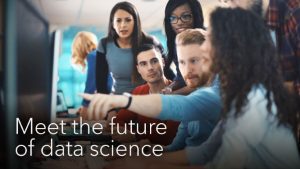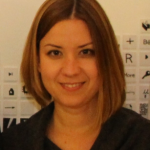 This post is the first in our Young Data Scientists series, featuring the motivation, work and advice of the next generation of data scientists. Be sure to check back for future posts, or read the whole series by clicking on the image to the right.
This post is the first in our Young Data Scientists series, featuring the motivation, work and advice of the next generation of data scientists. Be sure to check back for future posts, or read the whole series by clicking on the image to the right.
--------------------------------------------------------------------------------------------------------------------------------------------
Stefan Stoyanov is a Business Analytics and Research Intern at Boemska and a 2020 SAS Student Ambassador. He’s an MSc Business Analytics student with a passion for emerging technologies, ranging from artificial intelligence to augmented and virtual reality. We recently interviewed him to learn about his journey to becoming a data scientist.

What attracted you to data science as a career?
My primary goal is to work in a field where I can make a significant positive impact on the world.
Before my MSc Business Analytics course, I started working with tech companies on some EU projects. I was impressed by the huge positive impact technology can have not only on one company or local community, but for all humankind. I realised that I wanted to join the technology field and help enhance businesses and people's quality of life by developing the products and services of the future.
Among all tech-related fields, I chose data science because I am a curious person and want to explore and know more and more about the world around us. Data science allows you to explore and discover new insights and knowledge literally about everything around us. And this knowledge has the power to make the world a better place with a brighter future for all of us.
What area of data science do you want to focus on during the next five years?
There are so many options, and all of them are so exciting, but my primary interest lies in artificial intelligence and machine learning.
Can you tell us about some of the projects you’ve worked on?
At Surrey Business School, my colleagues and I worked on several interesting analytics projects. My first data analytics project aimed at predicting whether a customer of an insurance company was likely to purchase a caravan insurance policy and what was the profile of a typical caravan insurance buyer.
Within another project, I developed a research model explaining and predicting the individual customer profitability of a large retail bank, based on the concept of customer lifetime value.
I was also involved in a social media and text mining project, where my colleagues and I extracted insights from conversations among Nike customers on Twitter.
Another exciting project was the creation of an internal machine learning software application in R which identified valuable customers of a large telecommunications carrier who were likely to churn. Based on that, recommendations for marketing activities to retain these customers were given.
Do you think analytics can also bring benefits to society?
By analysing data, companies can deliver personalised goods and services to meet the specific needs of every individual customer better. Better forecasting of consumer demand allows businesses to optimise activities and reduce wasted resources across the whole supply chain. These optimisations can significantly decrease the carbon footprint and negative impact on the environment, thus helping to develop a more sustainable and prosperous society.
I am still at the beginning of my data science journey, and I can’t wait to work on more projects that will have a positive impact on humanity.
What motivates you and excites you about the future?
I am excited about the development of technology, data science, AI and analytics. I believe they will transform our world with unprecedented speed and in many ways over the near future.
There are many factors to facilitate advances in AI. The emergence of 3D, DNA and quantum computing will skyrocket the computing power in numbers that the human brain cannot even comprehend. Cloud-based services and 5G technology will also leverage the spread of AI and increased access to ever-expanding data. IDC predicts that worldwide data will grow from 33 zettabytes in 2018 to a 175ZB by 2025 and that almost half of it will be stored in the cloud. We will also benefit from the development and improvement of more and more sophisticated machine learning algorithms.
What excites me the most and keeps me going forward is my dream to be part of this positive change. In 2017, the Economist said that data is the world’s most valuable resource. However, several years ago, IDC estimated that only 0.5% of all data was analysed. Can you imagine the potential here? I want to help businesses and organisations in their digital transformation so they could make the most of their data.These factors will spur breakthroughs in science and will enable AI and machine learning (ML) to be infused into more business-critical applications in every industry. I believe these advances carry great potential to improve people’s quality of life, to make the world a more sustainable ecosystem and society more prosperous.
Your article “Game Changers” on LinkedIn focuses on what you can do with the SAS in-memory cloud analytics platform. How well does SAS Viya work alongside open source?
I fell in love with SAS Viya at first sight. One of the reasons is that the analytics platform nicely integrates the advantages of SAS software and open source solutions. The in-memory calculations in the cloud enable faster processing for vast amounts of data and complex analytics. SAS Viya hosts all necessary solutions for the execution of the entire analytics lifecycle. The platform has a beautiful interface with a well-structured visual analytics workflow. The navigation is intuitive and seamless.
The platform provides the user with easy to set up parameters of the analytical tasks. Moreover, many of them, such as the creation of different assessment graphs, model comparison and determination of the best performing model, are automated. The platform nicely integrates drag-and-drop interfaces with the possibility for writing, editing, running and deploying your code. Moreover, you can access your code through your preferred language for data analytics – SAS or open sources like Python, R or Lua. Also, they do not need to write any code from scratch, which saves lots of time. The standardised code base supported by SAS Viya also enables model deployment for cloud, on-site or hybrid environments.
All these features of SAS Viya democratise the analytics. They make the collaboration and use of advanced analytics tools more accessible to everyone in the enterprise - data scientists, business analysts, developers and decision-makers.
If you want to see and hear more from Stefan, make sure to attend his paper presentation, Enhancing Academic Teaching of Data Science with SAS Viya for Learners, at SAS Global Forum on March 30 in Washington, DC.
And if you want to learn more about data science, join the Data Science Experience virtual event on March 3, where you'll hear from experts from all over the world on the latest SAS applications and solutions for Data Scientists


1 Comment
Through SAS Viya, it is so much easier to get the result and modeling done, it helps the decision making better.